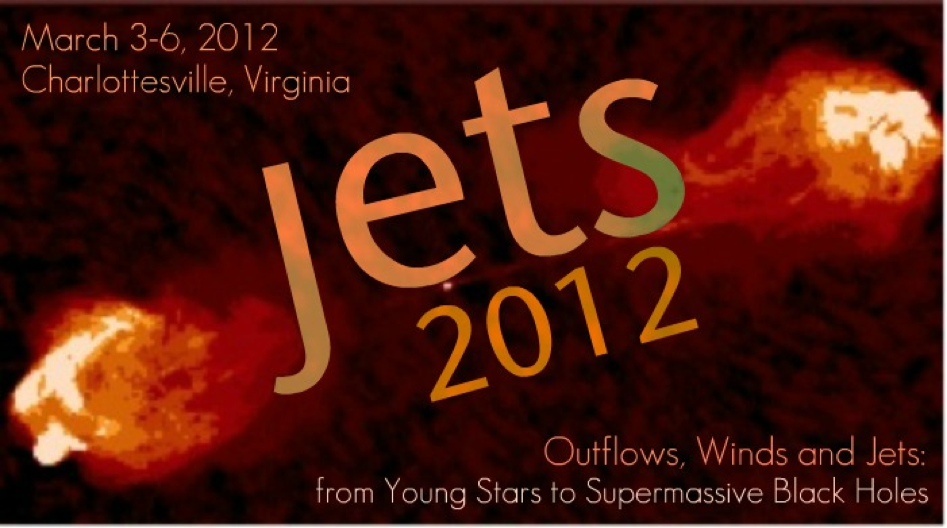NRAO eNews
Volume 4, Issue 11 • November 8, 2011
Upcoming Events
 ALMA Data Reduction Workshop
ALMA Data Reduction Workshop
Dec 1 - 2, 2011 | Charlottesville, VA
 NRAO Community Day
NRAO Community Day
Dec 15, 2011 | University of Maryland
 NRAO Town Hall at the 219th AAS
NRAO Town Hall at the 219th AAS
Jan 10, 2012 | Austin, TX
 ALMA Special Session at the 219th AAS
ALMA Special Session at the 219th AAS
Jan 11, 2012 | Austin, TX
 NRAO Community Day
NRAO Community Day
Jan 13, 2012 | UC Berkeley
 2nd EVLA Data Reduction Workshop
2nd EVLA Data Reduction Workshop
Feb 22 - Mar 1, 2012 | Socorro, NM
 Outflows, Winds and Jets Workshop
Outflows, Winds and Jets Workshop
Mar 3 - 6, 2012 | Charlottesville, VA
 Synthesis Imaging Workshop
Synthesis Imaging Workshop
May 29 - Jun 5, 2012 | Socorro, NM
ALMA Early Science Begins
Al Wootten
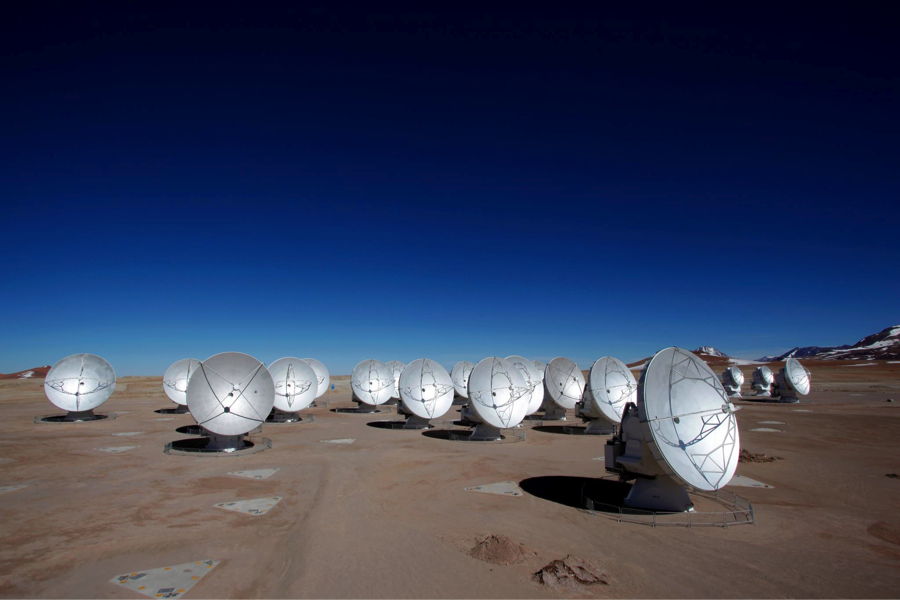
Figure 1. ALMA has grown to 22 telescopes including three 7m telescopes in the Atacama Compact Array (far right). On 16 Oct, the array at the 16500 ft elevation Array Operations Site (AOS) was preparing for observations of a second set of highly ranked proposals. Credit: Carlos Padilla (NRAO/AUI/NSF).
September closed with the beginning of Early Science on ALMA. The 500 hours allotted to the 112 highest-ranked (of 919 submitted) proposals for Cycle 0 Early Science occur in several-day batches spread throughout the semester; the first four-day block had about 40 hours allocated to Science Operations and progress was made on several proposals. A second, five-day block was scheduled mid-October and produced further observations. These first observations targeted projects seeking the more compact of the two Cycle 0 arrays (see Fig 1) for sources with appropriate sky positions.
Of the 112 highest priority projects whose observations have begun on ALMA, 38 were from the North American partners: the United States (35), Canada (3) and Taiwan. These were ranked most highly of the 280 proposals originating from the North American partners. Hence, the North American oversubscription rate for Cycle 0 Early Science was 7.4:1. A total of 236 N. A. scientists are collaborators on the 112 proposals given the Highest Priority for scheduling. These include 221 U.S. investigators at 55 different institutions. In North America, 935 astronomers registered at the ALMA portal. Worldwide, there were 2836 astronomers registered with ALMA and of those registered, nearly 90% were listed on one of the 919 submitted proposals.
During October four new sets of parts for AEM antennas arrived from Europe. The final three 7m antenna parts also arrived from Osaka via Kobe, completing delivery to the site of the entire Japanese complement of sixteen antennas. The 22nd North American antenna was shipped and is expected to arrive early in November. At the close of October, 51 of the ALMA antennas were on site. Twelve were under assembly at the Contractor areas, 7 were in testing at the Operations Support Facility (OSF), and 22 were at the AOS. Two of those at the OSF are due to arrive at the AOS by the beginning of November. Thus, more than one third of the final complement of 66 antennas to be delivered during construction are in use at the AOS.
Resolving Cluster Dynamics with MUSTANG and the GBT
Phil Korngut (University of Pennsylvania / Caltech) and Brian Mason (NRAO)
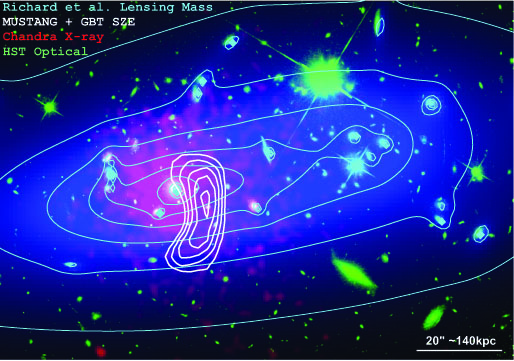
Figure 1. A multi-wavelength composite image of MACS0744. White contours show the MUSTANG+GBT detection of the SZE. Red shows the X-ray surface brightness as measured by the Chandra X-ray Observatory. Green is the optical emission from the Hubble Space Telescope. Blue contours and color-scale show the gravitational lensing mass reconstruction from Johan Richard. The resolved SZ image reveals a kidney-shaped ridge coincident with a sharp X-ray discontinuity interpreted as a bow shock in the ICM. The feature is located perpendicular to the mass elongation revealed by the lensing analysis, suggestive of a scenario in which an infalling subcluster has been stripped of its baryons after passing through the main core.
With masses ranging up to 1015 solar masses, clusters of galaxies are the largest gravitationally bound structures in the Universe. The majority of the luminous matter in these monsters is found not within the galaxies themselves, but in the form of a hot, diffuse atmosphere of gas ionized by the immense gravitational energy well in which it resides. The electrons in this hot intra-cluster medium (ICM) scatter photons from the cosmic microwave background (CMB) to higher energies resulting in a spectral distortion. At radio frequencies this is observationally manifested as a decrement in intensity known as the Sunyaev Zel'dovich Effect (SZE).
Measurements of the SZE at high angular resolution are difficult because of the large apertures required. Nearly all measurements in the literature have effective angular resolution larger than about 1 arcmin. These angular scales – corresponding to about 365 kpc at z = 0.5 – are useful for measuring bulk signal out to large cluster-centric radii, but are unable to resolve the smaller scale physical processes in the cluster cores. MUSTANG, a 90 GHz bolometer array camera on the 100-meter NRAO Green Bank Telescope (GBT), is changing this and ushering in a new era of high-angular resolution SZE measurements.
Using MUSTANG, our collaboration has made detailed measurements of four clusters of galaxies at 10 arcsec resolution with the goal of probing substructure in the ICM caused by merging processes (Korngut et al. 2011). Of particular interest are instances where cluster-cluster mergers are ongoing with in-fall velocities greater than the sound speed in the medium, about 1000 km/s. When a super-sonic merger occurs, it can produce a bow-shock in the plasma. The physical conditions across these shocks are constrained by the Rankine-Hugoniot jump conditions. By combining resolved SZE measurements with high resolution measurements from the Chandra X-ray Observatory, we can fit for the jump conditions and infer information on the merger, such as the shock velocity.
In the case of the cluster MACSJ0744+3927 (z = 0.69), the MUSTANG image reveals for the first time a kidney-shaped region of high-pressure gas close to the cluster core, coincident with a sharp surface brightness discontinuity in the X-ray image (see Figure 1). This multi-wavelength phenomenology, detected at over 5.5σ in the SZE alone, indicates that the system has recently been shock-heated. By fitting the jump conditions, we have inferred a shock velocity of 1827+267-195 km/s, a Mach number of about 1.2. Juxtaposing MUSTANG and Chandra data with the lensing mass map of Richard et al. (in prep.) shows that this system is a higher-redshift analog of the famous "Bullet Cluster" (Clowe et al. 2006), in which a secondary peak in mass density is evident with no associated baryons. This is expected in a scenario in which the in-falling cluster, originally consisting of dark matter and baryons, has passed through the main cluster, stripping it of its baryons, and is consistent with the current theory that dark matter is comprised of collision-less massive particles which do not interact electro-magnetically.
Because galaxy clusters are an important probe of dark energy, gravity, and cosmic structure evolution, major SZE surveys are underway which aim to map several thousand square degrees of sky to identify clusters out to well beyond z = 1 and measure their properties, primarily their masses. To understand and interpret these surveys it is important to have a firm grasp on the temporary deviations from equilibrium that are caused by mergers and other astrophysical processes, such as radio galaxy feedback. Our work with the GBT is an essential first step in that direction. Ultimately, we need detailed data on larger, more uniform samples of galaxy clusters, currently beyond the reach of the MUSTANG detector sensitivity. State-of-the-art bolometer detectors have reached 10x better sensitivities, and we are currently developing funding proposals for a larger field-of-view, more sensitive instrument (MUSTANG-2) to execute this survey.
References
- D. Clowe et al. 2006, ApJ 684, L109.
- P. Korngut et al. 2011 ApJ, 734, 10.
- J.E. Richard et al. in prep.
Barnard 5 Star-forming Core: Embedded Filaments Revealed
Jaime E. Pineda (ESO, and UK ALMA Regional Centre Node, University of Manchester)
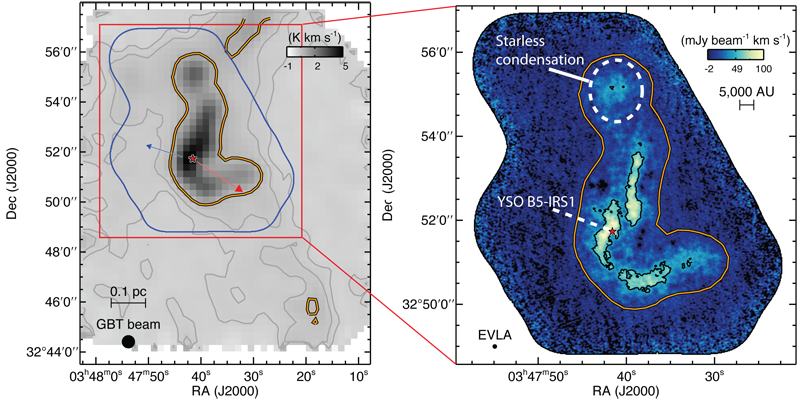
Figure 1. [Left panel]: integrated intensity map of B5 in NH3 (1,1) obtained with GBT. Gray contours show the 0.15 and 0.3 K km s–1 level in NH3 (1,1) integrated intensity. The orange contours show the region in the GBT data where the non-thermal velocity dispersion is subsonic. The young star B5-IRS1 is shown by the star in both panels. The arrows indicate the outflow direction. The blue contour shows the area observed with the EVLA and the red box shows the area shown in the right panel. [Right panel]: integrated intensity map of B5 in NH3 (1,1) obtained combining the EVLA and GBT data. Black contour shows the 50 mJy beam–1 km s–1 level in NH3 (1,1) integrated intensity. The dashed circle indicates the northern starless condensation.
Dense cores, regions of densities about 104 cm-3 and temperatures about 10K, are the sites where low-mass star are formed. These regions present subsonic line-widths, with are much narrower than those of the parental molecular cloud, which are supersonic. These dense cores could also fragment to produce separate stars.
Pineda et al. (2010) observed the Barnard 5 region in the Perseus molecular cloud with the Green Bank Telescope (GBT) in NH3. Those observations showed that the velocity dispersion in the central region of the core is small, presenting subsonic non-thermal motions that are independent of scale. Using these data, we presented the detection, for the first time, of the transition between the coherent core and the dense but more turbulent gas surrounding it. This transition is sharp, increasing the velocity dispersion by a factor of 2 in less than 0.04 pc (the GBT beam size at the 250 pc distance of Perseus). This dense core is as an exceptional place to study the fragmentation process in the star formation process.
Combining the previous GBT and new Expanded Very Large Array observations, Pineda et al. (2011) imaged the NH3 emission with high spectral and angular resolution the entire subsonic region in Barnard 5. These observations reveal, for the first time, the presence of a striking filamentary structure in this low-mass star-forming region that is 20 arcsec wide or 5000 AU at the distance of Perseus. The integrated intensity profile of this structure is consistent with models of an isothermal filament in hydrostatic equilibrium. Also, the observed separation between the B5–IRS1 young stellar object (YSO), in the central region of the core, and the northern starless condensation matches the Jeans length of the dense gas. This suggests that the dense gas in the coherent region is fragmenting. The observed region displays a narrow velocity dispersion, where most of the gas shows evidence for subsonic turbulence, and where little spatial variations are present. Only close to the YSO is an increase in the velocity dispersion found, though still showing subsonic non-thermal motions.
Among the remaining questions regarding the nature of the filament is: What is the temperature and density profile of the filament? Further high-resolution observations are in progress to obtain temperature and density maps of the region, and determine the nature of the filament.
References
- Jaime E. Pineda, Alyssa A. Goodman, Hector G. Arce, Paola Caselli, Jonathan B. Forster, Philip C. Myers, and Erik W. Rosolowsky, 2010 ApJL, 712, L116.
- Jaime E. Pineda, Alyssa A. Goodman, Hector G. Arce, Paola Caselli, Steven Longmore, and Stuartt Corder, 2011 ApJL, 739, L2.
NRAO Community Days
Gustaaf van Moorsel
NRAO is pleased to announce two community days: the first will be hosted by the University of Maryland on 15 December 2011, and the second will be hosted by UC Berkeley on 13 January 2012. Our goal is to showcase the NRAO instruments and provide information on how to propose and observe with ALMA, EVLA, VLBA, and GBT. We are still finalizing the schedule, but in the morning plan to provide an overview of the capabilities of each of our instruments, and give a presentation on considerations for a successful NRAO proposal. In the afternoon, there will be an opportunity for hands-on experience with the various observation preparation tools and with the post-processing system CASA. Further information and registration are available online.
ALMA Data Reduction Workshop
Carol Lonsdale
The NRAO North American ALMA Science Center is offering an ALMA Data Reduction workshop at NRAO Headquarters in Charlottesville, Virginia on 1-2 December 2011. A limited number of spaces are available. For more information and to register, please visit the Workshop website.
2nd EVLA Data Reduction Workshop
Gustaaf van Moorsel
NRAO is pleased to announce the second EVLA Data Reduction Workshop to be held from 22 February–1 March 2012 at the Pete V. Domenici Science Operations Center in Socorro, NM. The aim of the workshop is to help participants cope with the new challenges posed by the increased power and complexity of the EVLA. The focus will be on reducing data taken in the wide-band WIDAR modes available to the observing community since 30 September 2011.
Unlike the September 2011 workshop, this event will consist of two distinct parts. The first, from 22-24 February, will be organized much like the workshop held in September 2011, with presentations and hands-on tutorials. As in September, the number of participants will be limited to 40.
During the second part, from 27 February–1 March, participants will be given the opportunity to reduce their own EVLA data during which local staff will be available for consultation. Due to the increased resources required we have to limit the number of participants for this second part to 30.
Those interested can register for part 1, part 2, or both. For part 1, we will give preference to those who have not attended the workshop in September 2011. Since part II will require experience gained during either part 1 of this workshop, or the September 2011 workshop, we will give preference to those who have attended either of those events.
This is an advanced workshop, and unlike our Synthesis Imaging summer schools, is not intended for those who are new to radio interferometry. Prior experience with AIPS, CASA, or MIRIAD is required. We will be using CASA as our main data reduction package, but may use AIPS as well for some process steps, as needed. A working knowledge of CASA would be helpful.
To register please go to the Workshop's website at: https://science.nrao.edu/facilities/evla/early-science/DRW-spring2012 which contains further information and a preliminary program. We look forward to welcoming you to Socorro.
2012 Synthesis Imaging Workshop
Amy Mioduszewski
The 13th Synthesis Imaging Workshop will be held 29 May–5 June 2012 at the NRAO and New Mexico Institute of Mining and Technology in Socorro, NM. The Workshop will comprise a week of lectures on aperture synthesis theory and techniques at a level appropriate for graduate students in astrophysics. The Workshop will also include two days of practical tutorials demonstrating data collection, calibration, and imaging of various types of data, including new data from the EVLA, ALMA and the VLBA. More information on scheduled lectures and events is available online. If you are interested in receiving more information about the workshop, please pre-register on the same web page. A formal first announcement will be distributed in early 2012.
Outflows, Winds & Jets: from Young Stars to Supermassive Black Holess
The NRAO North American ALMA Science Center (NAASC) will host its 6th annual science workshop – Outflows, Winds and Jets: From Young Stars to Supermassive Black Holes – in Charlottesville, Virginia, 3-6 March 2012. The venue is the Omni hotel, located conveniently near downtown Charlottesville. Pre-registration is open at the conference web site . Pre-registration is not required, but will ensure that you receive timely information and updates about the conference program andlogistics. Abstract submission is now available online. Remember that students who have requested financial support must notify the LOC via the jets2012 email and submit an abstract to present at least a poster at the meeting. However, all students are strongly encouraged to request a contributed talk. Open registration for the Jets2012 meeting will be available beginning 15 November 2011.
Successful Completion of the GBT Dynamic Scheduling Project
Karen O'Neil
 A three-year project to improve the scheduling of the Green Bank Telescope (GBT) and provide significantly improved tools for the GBT scheduler and observers has come to a successful end. The GBT Dynamic Scheduling Systems (DSS) Project goal was to increase the average observing efficiency at high frequencies with the GBT while ensuring that none of the flexibility and ease of use of the GBT is harmed, and the data quality of observations is not adversely affected. The DSS has successfully met these goals, while also significantly easing the workload of the GBT scheduler and providing a new sensitivity calculator for all spectral line and continuum observations proposed for the GBT.
A three-year project to improve the scheduling of the Green Bank Telescope (GBT) and provide significantly improved tools for the GBT scheduler and observers has come to a successful end. The GBT Dynamic Scheduling Systems (DSS) Project goal was to increase the average observing efficiency at high frequencies with the GBT while ensuring that none of the flexibility and ease of use of the GBT is harmed, and the data quality of observations is not adversely affected. The DSS has successfully met these goals, while also significantly easing the workload of the GBT scheduler and providing a new sensitivity calculator for all spectral line and continuum observations proposed for the GBT.
NRAO would like to offer a sincere thank you to all GBT observers who provided feedback and suggestions during the DSS project, as well as the project’s external review teams. The project’s overall success could not have happened without this extensive external support. We would also like extend a large “congratulations” to all members of the DSS team, both past and present, for an excellent job done.
Full information on the DSS can be found online through the GBT observer’s guide and scheduling page. Requests for improvements and changes to the DSS are still possible as part of the general continuing maintenance and enhancement of all GBT software. Requests should be placed through the NRAO Helpdesk.
Recent Press Releases
ALMA Opens Its Eyes
3 October 2011
Humanity's most complex ground-based astronomy observatory, the Atacama Large Millimeter/submillimeter Array (ALMA), has officially opened for astronomers at its 16,500-feet elevation site in northern Chile. Read more.
First Images from ALMA
3 October 2011
The detailed views of star-formation in the Antennae Galaxies are the first astronomical test images released to the public from the growing Atacama Large Millimeter/submillimeter Array (ALMA) and confirm that this new telescope has surpassed all others of its kind. Read more.
Observatory Seeks a New Name for Transformed Scientific Icon
13 October 2011
The most famous radio telescope in the world is about to get a new name. Read more.
AUI & NRAO Join Chilean Science-Education Project
21 October 2011
The National Radio Astronomy Observatory (NRAO) and Associated Universities, Inc. (AUI), joined the National Copper Corporation of Chile (CODELCO) and the Center for Educational Innovation (CIE) of the University of Antofagasta in a project to build a center for training teachers from throughout Chile in astronomy and science. Read more.
Career Opportunities
New Postings
Systems Administrator I: The National Radio Astronomy Observatory in Green Bank, West Virginia is seeking a Systems Administrator I to provide support for a number of telescopes and science operations and collaborates with other NRAO facilities to provide Green Bank Telescope (GBT) and ALMA telescope and science computing support. This position will support local technical and scientific staff Redhat Linux systems and assist in the development and maintenance of the GBT data archive, high performance computing systems.
Co-Op Student: The NRAO in Socorro, NM is seeking a co-op student to work in the Electronics Division. The work assignment will involve performing RFI and EMC testing at the Very Large Array. Tasks will include the collection, analysis and presentation of monitoring system data, the location, identification and mitigation of detected RFI, and performing RF power measurements in a RF reverberation chamber. This position is temporary full-time for a period up to six months.
Software Engineer II: The NRAO in Socorro, NM is accepting applications for a Software Engineer II. The successful candidate will work on one or more of the following applications: Observation Preparation Tool, Observation Scheduling Tool, and Archive Access Tool as well as perform routine maintenance and add new features to these tools. Initially the Software Engineer II will work primarily, but not exclusively, on user interface code for our web applications.
Systems Administrator I: The National Radio Astronomy Observatory in Socorro, New Mexico is accepting applications for a Systems Administrator I. This position will support local technical and scientific staff Redhat Linux systems and assist in the development and maintenance of the EVLA and VLBA data archive, high performance computing systems.
NAASC Postdoctoral Fellow: The NRAO in Charlottesville, VA is seeking a postdoctoral fellow to work with the NAASC scientific staff. The successful candidate should expect to spend 50% of their time on independent research, with the remaining time spent on developing ALMA expertise and assisting the NAASC scientific staff in the support of ALMA users.
NRAO Postdoc: The NRAO in Socorro, NM is accepting applications for three postdoctoral positions to participate in the scientific commissioning and technical development of the EVLA and VLBA. These positions (50% research, 50% support) provide the opportunity for hands-on training in areas of technical expertise and observatory operations.
Jansky Fellow: The NRAO is recruiting for Jansky Fellows. The purpose of the Jansky Fellowship Program is to provide an opportunity for young scientists to establish themselves as independent researchers so that they may more effectively compete for permanent positions. Fellows formulate and carry out investigations either independently or in collaboration with others within the wide framework of interests of the Observatory.
NRAO Postdoc: The NRAO in Green Bank, WV is seeking a postdoctoral fellow to join their scientific staff. The NRAO Postdoc will have 50% of their time available for independent research and the remaining time will be devoted to support of the GBT and GBT observers.
Systems Administrator I: The NRAO in Charlottesville, VA is accepting applications for a Systems Administrator I. Under general supervision, the Database Systems Administrator will investigate reported issues and execute assigned implementation tasks for Oracle database and Linux server support.
Scientific Programmer: The NRAO in Charlottesville, VA is seeking a Scientific Programmer who will research and develop software to visualize and analyze ALMA data. The developer must become familiar with Common Astronomy Software Applications (CASA) code and practices, work within the existing CASA framework to improve and develop C++ code using the Qt platform, and extend the DBUS interface to enable interactive use of existing analysis tools within the CASA system.
Project Scientist: The NRAO in Green Bank, WV is recruiting for a Project Scientist. The successful candidate will provide scientific guidance to the project manager and project team; lead the testing and commissioning of the receivers on the 20 Meter Telescope; lead the development of a time allocation framework that enables scientific and educational users; and advise UNC scientists and programmers who are developing the user interface and data reduction tools as well as supervise early science with the 20 Meter.
From the Archives
Ellen Bouton
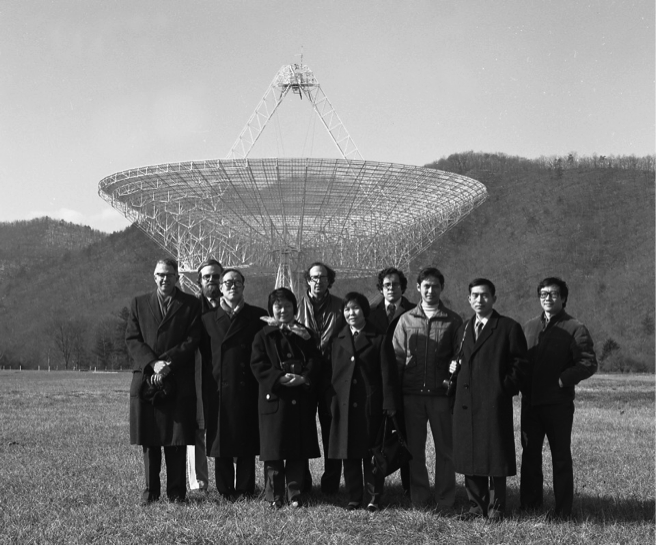
About this month's photograph: In November 1976, an official delegation of astronomers from the People's Republic of China visited the U.S. and on 18-19 November visited NRAO-Green Bank. They flew to Elkins, WV and drove over the mountains, accompanied by a U.S. Government escort. The U.S. government had also sent advance security personnel to check the site, including Redwood House, where Green Bank Site Director Bill Howard was living and where an evening reception was held (Bill Howard says security personnel even looked under the beds). In October 1977, NRAO Director David S. Heeschen was a member of the official U.S. delegation of astronomers who visited China. [Front row]: Bill Howard, Wang Shou Guan (Director of Beijing Observatory), Xiang Delin (Nanjing Observatory), unknown (possibly a translator), Zheng Yi Jia (Beijing Observatory), unknown, unknown. [Back row]: unknown, Ken Kellermann, unknown. Thanks to Bill Howard for background information and to Qifeng Yin for help with identifications. If any readers can identify the unknown people, please contact Ellen Bouton, ebouton@nrao.edu.
From the Archives is an ongoing series illustrating NRAO and U.S. radio astronomy history via images selected from our collections of individuals' and institutional papers. If readers have images they believe would be of interest to the Archives, please contact Ellen Bouton, ebouton@nrao.edu.

 Zoom
Zoom